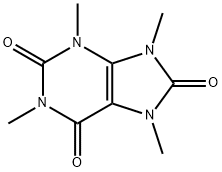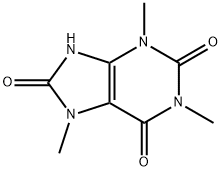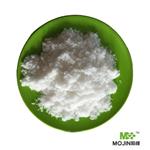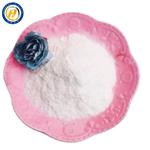Uses
Tetramethyluric acid is an impurity of caffeine. Caffeine is a bitter, white crystalline xanthine alkaloid that acts as a stimulant drug and a reversible acetylcholinesterase inhibitor. Caffeine is found in varying quantities in the seeds, leaves, and fruit of some plants, where it acts as a natural pesticide that paralyzes and kills certain insects feeding on the plants. In humans, caffeine acts as a central nervous system stimulant, temporarily warding off drowsiness and restoring alertness. Caffeine is a cardiac and respiratory stimulant; diuretic. Caffeine is toxic at sufficiently high doses.
Definition
ChEBI: 1,3,7,9-tetramethyluric acid is an oxopurine that is uric acid in which the hydrogens at positions 1,3,7 and 9 are replaced by methyl groups. It is a purine alkaloid that is found in Chinese tea known as kucha (Camellia assamica var. kucha) and exhibits anti-inflammatory and analgesic properties. It has a role as a plant metabolite, an anti-inflammatory agent, an analgesic and a human xenobiotic metabolite. It is an oxopurine and a purine alkaloid. It is functionally related to a 7,9-dihydro-1H-purine-2,6,8(3H)-trione.
Purification Methods
Crystallise the uric acid from H2O or MeOH. [Beilstein 26 H 532, 26 I 156, 26 II 302, 21 III/IV 2623.]







